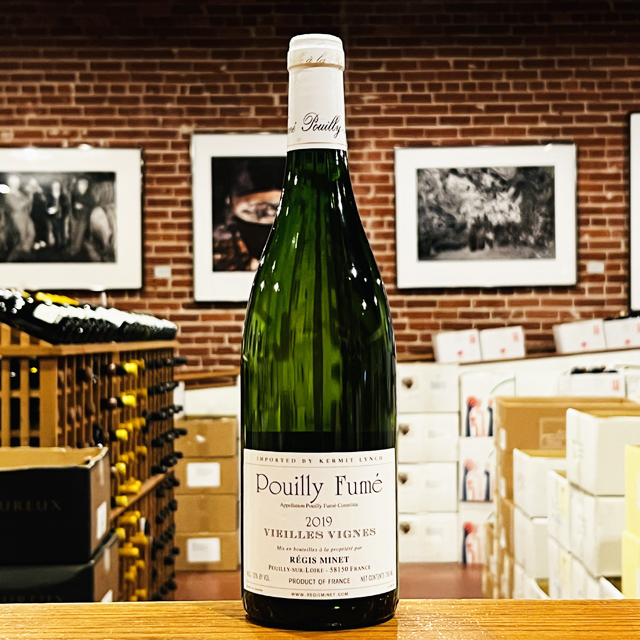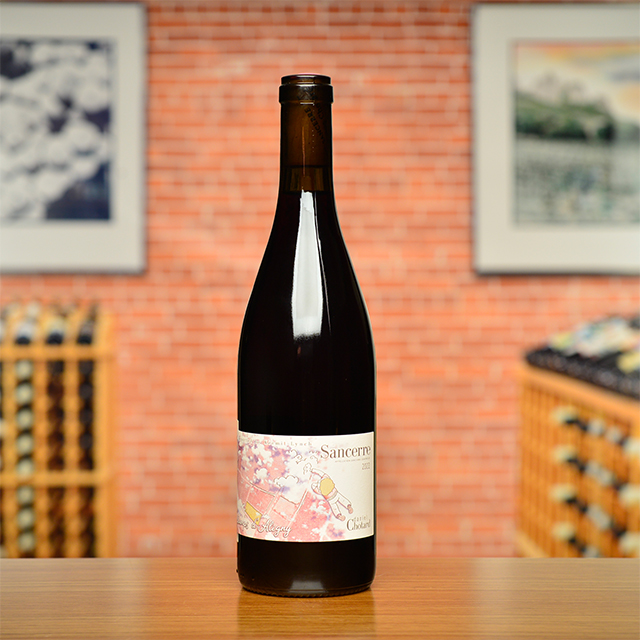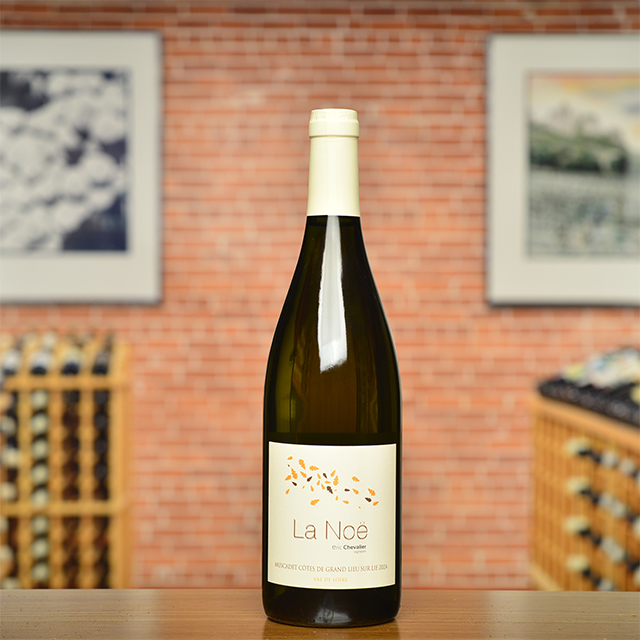Notify me
2019 Pouilly-Fumé “Vieilles Vignes”
Régis Minet
If you appreciate the steely mineral dimension as much as the exotic aromas of Pouilly-Fumé, try this bottling. It has palpable texture—fine-grained, like the smoothness of pebbles in your hand. Take a tip from Monsieur Minet (who always introduces himself as “Régis from Pouilly”): the 2019 is lush and certainly more abundant than he anticipates the upcoming vintage will be.
—Emily Spillmann
| Wine Type: | white |
| Vintage: | 2019 |
| Bottle Size: | 750mL |
| Blend: | Sauvignon Blanc |
| Appellation: | Pouilly Fumé |
| Country: | France |
| Region: | Loire |
| Producer: | Régis Minet |
| Winemaker: | Régis Minet |
| Vineyard: | 25 - 30 years, 10 ha |
| Soil: | Clay, Marl, Kimmeridgian Limestone |
| Aging: | Wine ages for 6 months on fine lees in stainless steel. Depending on the vintage, the lees are stirred two to three times during this time |
| Farming: | Lutte Raisonnée |
| Alcohol: | 13% |
More from this Producer or Region

2022 Jasnières “Dyane”
France | Loire
Juicy and open-knit, it mirrors the sensation of biting into fleshy slices of white peach, nectarine, and guava.

2022 Sancerre Rouge “Champs d’Alligny”
France | Loire
Previously blended into the domaine’s Sancerre rouge, the Champs d’Alligny is now its own bottling, a successful experiment if there ever was one.

2021 Bourgueil “La Dilettante”
France | Loire
A delicate, aromatic red in the “drink now!” vein.

2022 Chinon Blanc
France | Loire
Ultra fresh and brimming with citrus blossom and orchard fruit notes, it has a saline, mineral finish that leaves my palate begging for more.

2024 Val de Loire Sauvignon Blanc “Unique”
France | Loire
Lime blossoms delivered via a lightning bolt of minerally refreshment.

2023 Savennières
France | Loire
Savennières is home to some of the greatest terroirs for this grape variety thanks to its soils of schist, sandstone, and blue slate and its proximity to the moderating Loire River.

2024 Pouilly-Fumé “Vieilles Vignes”
France | Loire
The classic Sauvignon Blanc characteristics are present, but understated—floral notes, subtle citrus, a cool grassiness—and there’s a chalkiness so textural you can feel it as you taste.

2024 Muscadet Côtes de Grand Lieu sur lie “La Nöe”
France | Loire
At first, it is streamlined, saline, and full of lemon. Then the granite terroir kicks in...

2022 Jasnières “Cuvée Sainte Narcisse”
France | Loire
It might be the most unusual and most delicious top-quality sweet wine you have ever tried.

2024 Bourgueil “Cuvée Alouettes”
France | Loire
Alouettes harkens to a different era: it’s pleasantly tannic and chalky, with sleek notes of licorice, cranberry, and prickly black pepper.
About The Producer
Régis Minet
About The Region
Loire

The defining feature of the Loire Valley, not surprisingly, is the Loire River. As the longest river in France, spanning more than 600 miles, this river connects seemingly disparate wine regions. Why else would Sancerre, with its Kimmeridgian limestone terroir be connected to Muscadet, an appellation that is 250 miles away?
Secondary in relevance to the historical, climatic, environmental, and cultural importance of the river are the wines and châteaux of the Jardin de la France. The kings and nobility of France built many hundreds of châteaux in the Loire but wine preceded the arrival of the noblesse and has since out-lived them as well.
Diversity abounds in the Loire. The aforementioned Kimmeridgian limestone of Sancerre is also found in Chablis. Chinon, Bourgueil, and Saumur boast the presence of tuffeau, a type of limestone unique to the Loire that has a yellowish tinge and a chalky texture. Savennières has schist, while Muscadet has volcanic, granite, and serpentinite based soils. In addition to geologic diversity, many, grape varieties are grown there too: Cabernet Franc, Chenin Blanc, Sauvignon Blanc, and Melon de Bourgogne are most prevalent, but (to name a few) Pinot Gris, Grolleau, Pinot Noir, Pineau d’Aunis, and Folle Blanche are also planted. These myriad of viticultural influences leads to the high quality production of every type of wine: red, white, rosé, sparkling, and dessert.
Like the Rhône and Provence, some of Kermit’s first imports came from the Loire, most notably the wines of Charles Joguet and Château d’Epiré—two producers who are featured in Kermit’s book Adventures on the Wine Route and with whom we still work today.
More from Loire or France
2024 Muscadet “Le Clos de la Butte”
Eric Chevalier France | Loire
2017 Jasnières “Chant de Vigne”
Christine de Mianville France | Loire
2023 Chinon “Beaux Monts”
Catherine & Pierre Breton France | Loire
2021 Saumur Blanc “Terres”
Thierry Germain France | Loire
2022 Chinon “Cuvée Terroir”
Charles Joguet France | Loire
2020 Vin de France Blanche
Domaine Michel Brégeon France | Loire
2024 Vouvray
Champalou France | Loire
2022 Chinon Blanc
Bernard Baudry France | Loire
2024 Coteaux du Loir Blanc
Pascal Janvier France | Loire
2019 Saumur Blanc “Le Clos du Moulin”
Thierry Germain France | Loire
2024 Vin de France Rosé Brut “Elle est pas bulle la vie?”
Catherine & Pierre Breton France | Loire
2024 Reuilly “Les Pierres Plates”
Domaine de Reuilly France | Loire
2024 Muscadet “Le Clos de la Butte”
Eric Chevalier France | Loire
2017 Jasnières “Chant de Vigne”
Christine de Mianville France | Loire
2023 Chinon “Beaux Monts”
Catherine & Pierre Breton France | Loire
2021 Saumur Blanc “Terres”
Thierry Germain France | Loire
2022 Chinon “Cuvée Terroir”
Charles Joguet France | Loire
2020 Vin de France Blanche
Domaine Michel Brégeon France | Loire
2024 Vouvray
Champalou France | Loire
2022 Chinon Blanc
Bernard Baudry France | Loire
2024 Coteaux du Loir Blanc
Pascal Janvier France | Loire
2019 Saumur Blanc “Le Clos du Moulin”
Thierry Germain France | Loire
2024 Vin de France Rosé Brut “Elle est pas bulle la vie?”
Catherine & Pierre Breton France | Loire
2024 Reuilly “Les Pierres Plates”
Domaine de Reuilly France | Loire
Kermit once said...

Kermit once said...
For the wines that I buy I insist that the winemaker leave them whole, intact. I go into the cellars now and select specific barrels or cuvées, and I request that they be bottled without stripping them with filters or other devices. This means that many of our wines will arrive with a smudge of sediment and will throw a more important deposit as time goes by, It also means the wine will taste better.
















